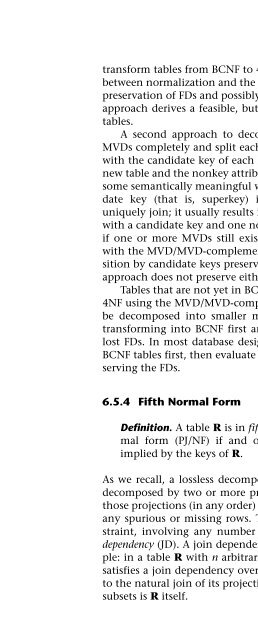Database Modeling and Design
Database Modeling and Design
Database Modeling and Design
Create successful ePaper yourself
Turn your PDF publications into a flip-book with our unique Google optimized e-Paper software.
6.5 Fourth <strong>and</strong> Fifth Normal Forms 133<br />
transform tables from BCNF to 4NF must take into account the trade-off<br />
between normalization <strong>and</strong> the elimination of delete anomalies, <strong>and</strong> the<br />
preservation of FDs <strong>and</strong> possibly MVDs. It should also be noted that this<br />
approach derives a feasible, but not necessarily a minimum, set of 4NF<br />
tables.<br />
A second approach to decomposing BCNF tables is to ignore the<br />
MVDs completely <strong>and</strong> split each BCNF table into a set of smaller tables,<br />
with the c<strong>and</strong>idate key of each BCNF table being the c<strong>and</strong>idate key of a<br />
new table <strong>and</strong> the nonkey attributes distributed among the new tables in<br />
some semantically meaningful way. This form of decomposing by c<strong>and</strong>idate<br />
key (that is, superkey) is lossless because the c<strong>and</strong>idate keys<br />
uniquely join; it usually results in the simplest form of 5NF tables, those<br />
with a c<strong>and</strong>idate key <strong>and</strong> one nonkey attribute, <strong>and</strong> no MVDs. However,<br />
if one or more MVDs still exist, further decomposition must be done<br />
with the MVD/MVD-complement approach given above. The decomposition<br />
by c<strong>and</strong>idate keys preserves FDs, but the MVD/MVD-complement<br />
approach does not preserve either FDs or MVDs.<br />
Tables that are not yet in BCNF can also be directly decomposed into<br />
4NF using the MVD/MVD-complement approach. Such tables can often<br />
be decomposed into smaller minimum sets than those derived from<br />
transforming into BCNF first <strong>and</strong> then 4NF, but with a greater cost of<br />
lost FDs. In most database design situations, it is preferable to develop<br />
BCNF tables first, then evaluate the need to normalize further while preserving<br />
the FDs.<br />
6.5.4 Fifth Normal Form<br />
Definition. A table R is in fifth normal form (5NF) or project-join normal<br />
form (PJ/NF) if <strong>and</strong> only if every join dependency in R is<br />
implied by the keys of R.<br />
As we recall, a lossless decomposition of a table implies that it can be<br />
decomposed by two or more projections, followed by a natural join of<br />
those projections (in any order) that results in the original table, without<br />
any spurious or missing rows. The general lossless decomposition constraint,<br />
involving any number of projections, is also known as a join<br />
dependency (JD). A join dependency is illustrated by the following example:<br />
in a table R with n arbitrary subsets of the set of attributes of R, R<br />
satisfies a join dependency over these n subsets if <strong>and</strong> only if R is equal<br />
to the natural join of its projections on them. A JD is trivial if one of the<br />
subsets is R itself.




